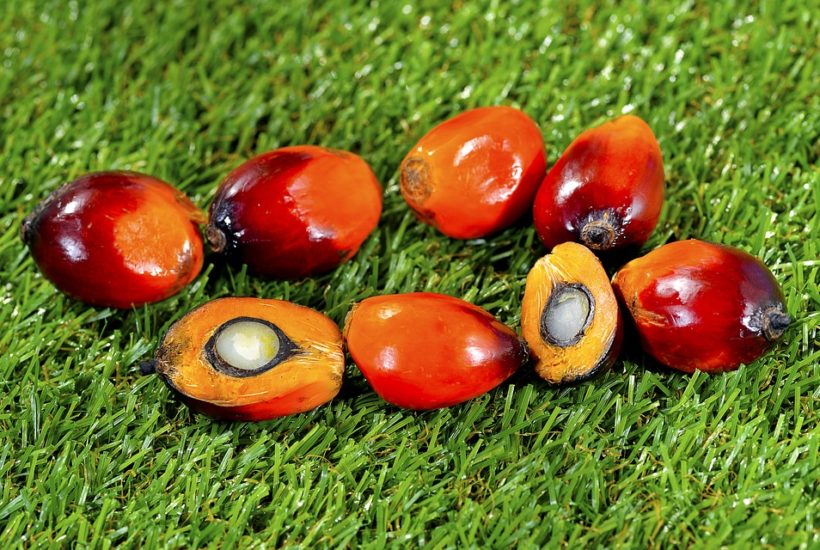Featured
Palm oil rises on demand prospects as the US dollar stays strong
Palm oil continued to move higher last week on ideas that demand could improve and as the US dollar held strong. Palm oil production ideas remain high, and both Malaysia and Indonesia are talking about big production. Exports from Malaysia has increased in July. The production is strong enough so that the improved demand will not create tight stocks.

Wheat
Wheat markets were mixed, with Chicago SRW prices a little higher and Chicago HRW and Minneapolis Spring Wheat prices a little lower. The markets held fairly well considering the weakness in world markets. The weekly export sales report was positive as demand is increasing with weaker prices. Winter Wheat harvest activities are winding down in the north and are completed in the south. Spring Wheat harvest is moving slowly and is expanding into Canada. That usually means that the seasonal low is not that far away.
The weekly charts show that futures are getting oversold and that a bottom is possible. Upside price potential is thought to be somewhat limited as there is a lot of Wheat available to the world market and the US Dollar has been stronger to keep US prices on the defensive. Harvests in the northern half of the world are coming to an end with Russia and Europe offering. Egypt has been able to buy from eastern Europe at cheaper prices and has increased its purchase volumes in recent weeks. But the US is also seeing an increased business on the export side and reports indicate that demand for Wheat as feed is strong inside the US. Wheat prices could turn sideways or could stage a short term rally in the near future.
Corn
Corn closed lower but held the lows from the previous week. Oats were also lower and appear ready to take a new leg down on the weekly charts. The lack of export and domestic demand has really hurt the corn market this year and demand prospects are not improving even with the weaker prices. The weekly export sales reports continue to show just tepid demand. Strong competition is coming from South America and Eastern Europe will challenge for sales as well.
Demand for ethanol is becoming a problem after the Trump administration allowed waivers for 31 smaller refineries last week. They need not blend with ethanol anymore so Corn demand will be less. Ethanol manufacturers are starting to reduce operations due to these and previous waivers that have hurt demand and prices. Feed demand has been a problem for the last year and should continue to be a problem despite high animal numbers in the US as feed interests look to cheaper alternatives. The Pro Farmer crop tour covered much of the Midwest last week and found extremely uneven conditions. It estimated US Corn production at 13.358 billion bushels on yields of 163.3 bushels per acre. USDA had estimated production at 13.901 billion bushels on an average yield of 169.5 bushels per acre.
The Pro Farmer estimate appears to be realistic based on the extremely uneven growing conditions seen this year. Tour participants noted that the crop development remains very far behind normal so it will be a race against first freeze dates to get this crop to maturity. An early freeze this year could cause a much smaller crop, but a late freeze could cause yields to increase slightly.
Soybeans and soybean meal
Soybeans and Soybean Meal closed lower last week but held at or above the recent lows. Export demand has been a problem with the trade war heating up with China. Old crop Soybeans export sales have been dismal lately but new crop sales have been much better, although still far from spectacular. Soybean Meal export sales have been consistent but not really strong. The Pro Farmer crop tour found very immature crops in almost all areas. Soybeans appear farther behind than Corn and getting the crop to maturity before first freeze dates will be a real challenge. The tour found low pod counts in almost all areas.
Pro Farmer estimated production at 3/497 billion bushels on yields of 46.1 bushels per acre. USDA had estimated production at 3.680 billion bushels ion yields of 48.5 bushels per acre. Pro Farmer could be high in its estimates given the lateness of the crop and the lack of pod counts. Even so, the market needs demand and finding demand will remain hard given the tepid export market and trade wars that the US is involved within just about all corners of the globe. Domestc meal demand could improve if DDG production is less due to reduced ethanol production, but Soybean Oil demand will be hurt due to the spate of biofuels waivers the US government has granted lately.
Rice
Rice was lower last week and trends remain down in this market. The weekly charts show that there is some significant support near the lows of the week but that futures could drop to about 1050 basis the nearest contract. The harvest is active in Texas and Louisiana and is just getting started in the other states. Field yields have been average at best in the south. It is too early to know much about yields farther to the north.
Harvest progress in the north will be slow due to the late planting from the very wet Spring. The weekly export sales report showed good demand for long-grain paddy to Central America. Export demand in general has been solid this year and should continue generally strong with no real competition noted from /south America for sales in the western hemisphere. Demand from other areas such as the Middle East will be more problematic as Asia can also service this market.
Palm oil and vegetable oils
World vegetable oils markets were mixed as Palm Oil continued to move higher but Soybean Oil and Canola moved lower. Palm Oil was high last week on ideas that demand could improve and as the US Dollar held strong. Production ideas remain high for Palm Oil with both Malaysia and Indonesia talking about big production. The export pace from Malaysia has improved as more was exported in July than in June, but ideas are that the production is strong enough so that the improved demand will not do that much to create a tight stocks scenario. Exports for much of August have held firm.
The weather has featured some rains but also dry periods and is being called good for Palm Oil production. Soybean Oil was lower as the US government approved biofuels demand waivers for another 31 small refineries. The US government has hurt demand ideas in a big way and biofuels processors are responding but cutting production schedules and in some cases closing some plants. The US is facing increased competition for sales now from South America, and mostly from Argentina. Argentina has traditionally been the major source for Soybean Oil in the world market as it prefers to use other oils at home for its cooking needs. Canola was slightly lower last week as the harvest came closer.
Parts of the Prairies remain too dry although rains have increased lately. The provincial reports have noted the uneven conditions as the growing conditions have been rated less than 50% good to excellent. Production ideas are starting to slide again as the trade waits for StatsCan estimates to be released this week. Demand has been strong recently as domestic crushers try to take advantage of very positive crush margins.
Cotton
Cotton was lower but held within the range of the last few weeks. Export demand was down last week after the big sales to Bangladesh the previous week. Crop condition ratings were down as well as the Texas Panhandle crop continues to slide due to hot and dry weather in the region. Some of the crop is irrigated, but even these crops appear to be showing some stress. There is talk that USDA will need to trim production estimates due to the stress to the crop in Texas.
Crops in the Delta and Southeast appear to be in mostly very good condition. These areas have seen plenty of precipitation and more moderate temperatures. Production east of Texas should be very good. Certified stocks are about half of what they were a month ago and it looks like producers are not selling. They are upset with the prices and are in no rush to sell at current levels. Much of the Cotton could be put under loan this year.
World markets are also showing weaker prices as China appears to be out of the market. Chinese domestic prices are on par with or are cheaper than world values and the domestic industry is concentrating on using the local crop and will only enter the world market to buy higher end supplies for blending. These supplies will come from countries other than the US this year.
Frozen concentrated orange juice and citrus
FCOJ was a little lower again last week but recovered from the worst levels of the week as the tropical weather started to get more active in the Atlantic. The weekly charts show that futures held a support area near recent lows. Chart patterns remain generally weak due to good weather in Florida and ideas of good oranges crop production potential. The weather in Florida remained tranquil as the state has seen frequent showers and storms that have aided in development in the fruit. Some big storms were seen in southern and eastern areas from a storm that is now moving up the East Coast. There are no hurricanes likely to hit the state this week. However, waves are starting to come off the coast of Africa that could form into hurricanes later.
The weather in the ocean has not been good for storm development as the air has been dry and there has been enough wind to keep storms from forming. This could be changing as the most active part of the hurricane season is coming now. Inventories in Florida are still 17 percent above a year ago. Fruit for the next crop is developing and are as big as baseballs. Crop conditions are called good. Mostly good conditions are reported in Brazil.
Coffee
Futures closed a little lower in both markets in more tow sided trading than what has been seen lately. Ideas are that the export pace from Brazil remains strong and as roaster buying remains generally hard to find. The new harvest is now almost over and is available so the country should be able to keep up a strong export pace for at least the next few months. Almost half of the crop has been sold by producers according to private analysts in the country. Reports indicate that the yields are not really strong and that the quality of the crop is poor due to extreme weather seen early in the growing season.
Vietnam is also reporting lower yields for the current crop as the weather was not good for flowering earlier in the year. There have been some hot and dry spells that have hurt yield and quality for these crops as well, but showers are reported in the Central Highlands recently and some flooding was reported. Production ideas are starting to come down. Robusta prices are holding better than Arabica prices due to the Vietnamese weather and also due to some reports of drier weather in Indonesia. Central America has Coffee on offer, but bid prices from buyers have been very low.
Sugar
Futures closed lower for the week in both markets. It was a quiet week and the trading ranges were narrow for both markets. World supplies still appear ample for the demand potential. Reports from India indicate that the country still has a large surplus of White Sugar that probably must be exported. India is reporting below-normal monsoon rains, but rains have been much better lately. The last couple of weeks have featured above average rains. There are concerns that the Indian monsoon will not be strong this year and that Sugarcane production could be hurt.
Processing of Sugarcane in Brazil is slower and the pace of the crush is behind last year. Mills are refining mostly for ethanol right now as has been the case all season. The fundamentals still suggest big supplies, and the weather in Brazil is good enough and India has improved to support some of the big production ideas.
Cocoa
Futures closed higher in both markets with the best gains seen in New York. It looked like speculators were covering some short positions. The weather in West Africa is still a feature. The weather in Ivory Coast has improved due to reports of frequent showers. Some showers in West Africa now help relieve stress on trees. Ideas are that the next crop will be good. The harvest will start in the Fall.
Growing and harvesting conditions in Asia are also reported to be good. The harvest is ongoing amid showers, but good progress in the harvest is expected at this time. More and more Asian Cocoa has been staying at home and processed in Indonesia for export in the region. Demand in Asia has been growing and Indonesia has been eager to be the primary source of Cocoa.
—
DISCLAIMER: This article expresses my own ideas and opinions. Any information I have shared are from sources that I believe to be reliable and accurate. I did not receive any financial compensation for writing this post, nor do I own any shares in any company I’ve mentioned. I encourage any reader to do their own diligent research first before making any investment decisions.

-

 Cannabis6 days ago
Cannabis6 days agoRecord-Breaking Mary Jane Fair in Berlin Highlights Cannabis Boom Amid Political Uncertainty
-

 Impact Investing2 weeks ago
Impact Investing2 weeks agoGlobal Gender Gap Progress Slows Amid Persistent Inequality and Emerging Risks
-

 Biotech3 days ago
Biotech3 days agoVytrus Biotech Marks Historic 2024 with Sustainability Milestones and 35% Revenue Growth
-

 Crowdfunding2 weeks ago
Crowdfunding2 weeks agoColombia Approves Terrenta’s Crowdfunding Platform for Real Estate Financing























